MXA MOTOCROSS RACE TEST: 2018 HONDA CRF450
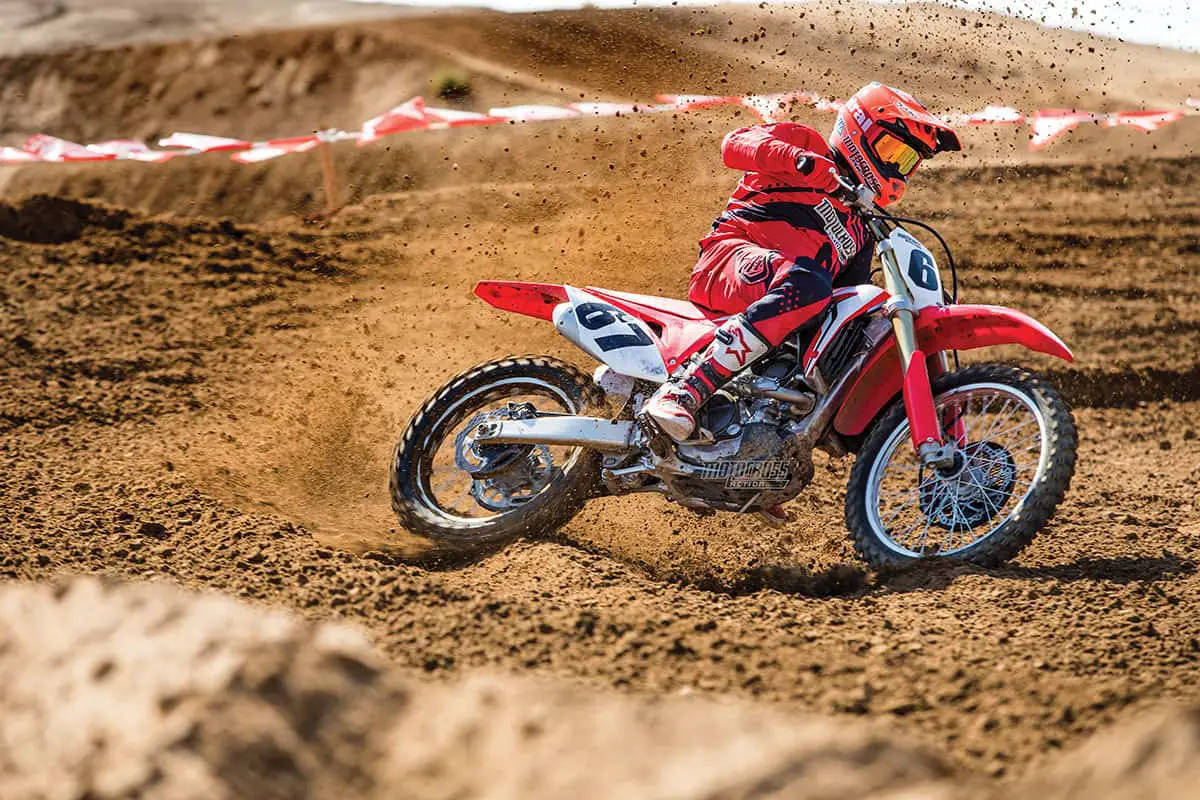 When the 2018 CRF450 is in the midrange and hooked up, it is a thing of beauty to ride. It’s a little less thrilling off the bottom.
When the 2018 CRF450 is in the midrange and hooked up, it is a thing of beauty to ride. It’s a little less thrilling off the bottom.
Q: FIRST AND FOREMOST, IS THE 2018 CRF450 BETTER THAN THE 2017 CRF450?
A: Yes. The 2018 Honda CRF450 reinforces the old adage “never buy a first-year model.”
Q: WHAT DID HONDA CHANGE ON THE CRF450 FOR 2018?
A: Obviously, it was hard for Honda to scrape up R&D money 12 months after blowing a big wad on the all-new 2017 model. But, Honda’s engineers knew what was wrong with the 2017 CRF450 and they penny pinched their way to a small list of mods that the 2018 CRF450 could not live without. Here is the list.
(1) Electric starting. Although the 2018 CRF450 could live without an electric starter, every project manager wanted one on their new bike because it is buzz-worthy. In the case of Honda and Yamaha, they really couldn’t afford the almost 5-pound weight penalty that comes with electric starting, but they did it anyway. In the Honda’s case, the 2018 CRF450 now weighs 240 pounds. Last year it weighed 233 pounds. The electric starter, battery, wiring hardness and the stiffer fork and shock springs are the culprits
(2) Black box. Last year the MXA wrecking crew struggled with the electronics of the CRF450. Eventually, we teamed up with Honda’s R&D department to test different maps. We selected the best one for our test bike, and, as it turns out, Honda selected a map that was very close to this map for the 2018 model.
(3) Suspension. Last year’s Showa fork and shock were too soft for fast riders and too harsh for slow riders. The simplest and cheapest solution was to replace the stock 0.48 N/m fork springs with the stiffer 0.50 N/m fork springs and the stock 54 N/m shock spring with a firmer 56 N/m spring. Guess what? MXA’s 2017 spring rates are Honda’s 2018 spring rates (with valving to go with them).
(4) Head stays. For 2018, the CRF450 gets thinner and flexier head stays. These are not the same as the CRF450RX mounts that we suggested switching to last year. They are purpose-built to make the chassis feel more resilient.
(5) Mapping. The 2018 comes with three maps that are accessed via a handlebar-mounted button. Map one is the stock map, which is different from last year’s map. It is broader and more alive through the midrange. Map two is the mellow map. It makes fewer horsepower than the stock map with a little less crispness. Map three is the aggressive map. It hits harder and snaps to attention quicker. Now, you wouldn’t be wrong if you said, “That is exactly what last year’s maps did.” But, the difference is that last year’s stock map was closer in performance to the mellow map and distinctly different from the aggressive map. Now, for 2018, the stock map is slotted midway between mellow and aggressive, which means it is a little more like the aggressive map and a little less like the mellow map.
(6) Price. The 2018 Honda has an MSRP that is $300 more than last year. That may seem like a giant price leap, but given that buying last year’s accessory electric starter kit, wiring harness and battery, plus paying for labor to install it, would cost three times more than $300, the 2018 price is a bargain of sorts.
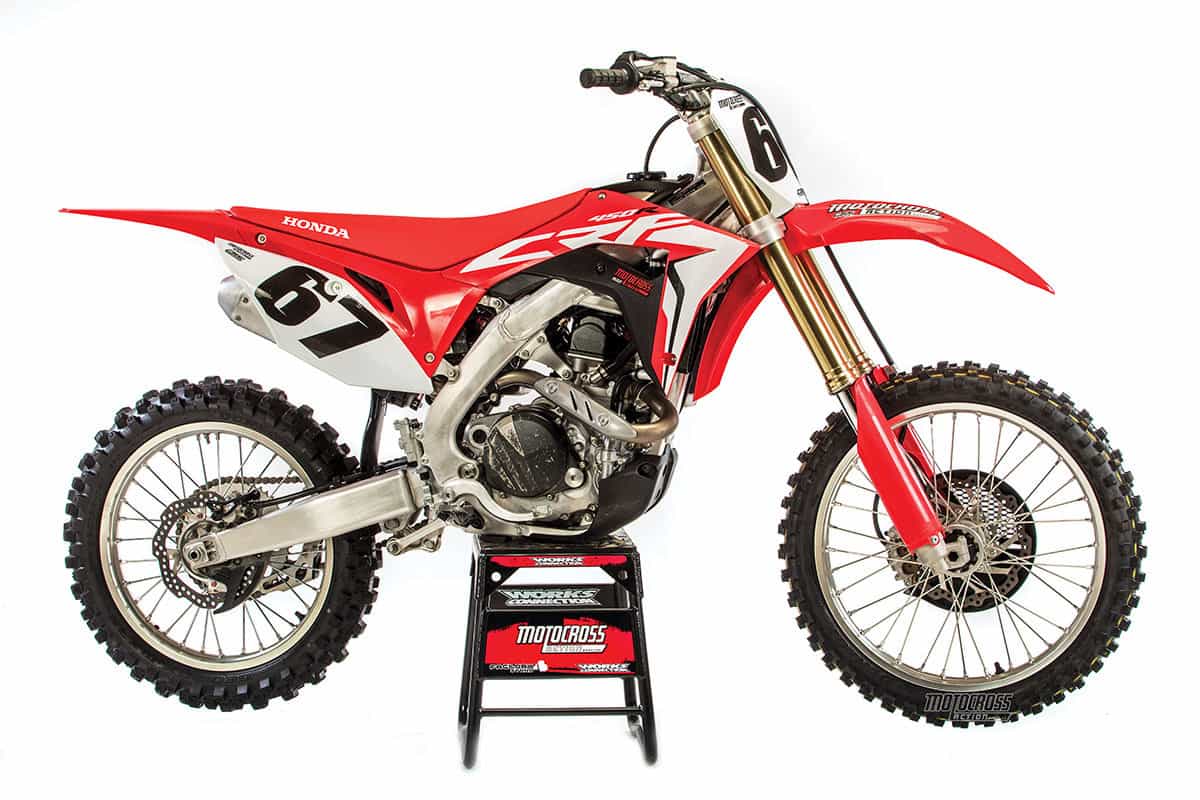 If you are looking for clues for how to tell a 2018 CRF450 from the 2017, the first thing you’ll notice is the lack of a kickstarter. Harder to spot is the electric start button on the handlebars.
If you are looking for clues for how to tell a 2018 CRF450 from the 2017, the first thing you’ll notice is the lack of a kickstarter. Harder to spot is the electric start button on the handlebars.
Q: WHAT FIVE CHANGES DID HONDA NEED TO MAKE BUT DIDN’T?
A: With an all-new 2018 Honda CRF250 getting all the budget love for 2018, Honda couldn’t do everything that it needed to do, but you can fix the things Honda didn’t have the spare change for.
(1) Radiator louvers. The gaps between the radiator louvers are so wide that more roost gets through than is deflected. If you don’t want to be spending your kid’s college tuition on new CRF450 radiators, invest in the mesh-like Twin Air radiator sleeves.
(2) Radiator cap. In MXA’s endurance testing, we had issues with the 2018 CRF450 pumping out fluid. The stock 1.1 kg/cm2 radiator cap is not up to the task. we went to a higher pressure cap and switched to Evan Waterless coolant to stop Honda’s version of Old Faithfui.
(3) Clutch. Honda’s new seven-plate clutch works a lot better if you remove the judder spring and judder plate and replace them with one additional true-to-life fiber plate. The judder plate isn’t a plus, and to make matters worse, it breaks. Honda should just go back to the eight-plate clutch from 2008 CRF450 and end this clutch plate roulette.
(4) Exhaust pipe. Having two mufflers is Honda’s signature move on its motocross bikes; however, on a bike that weighs 18 pounds more than a KTM 450SXF and 7 pounds more than a 2017 Honda CRF450, we don’t think that the extra weight is something we’d be signing our names to.
(5) Titanium gas tank. This must have sounded like a cool idea in the boardroom, but nobody told the pencil pushers that when it was actually mounted on the bike it would be virtually invisible. It isn’t significantly lighter than a plastic tank. The gas cap sticks, and it raises the price tag. It stiffens the already rigid Honda chassis to the point that MXA removes the two rear gas tank bolts to free the frame up. Thus, we don’t think the idea was fully thought out. However, we’d be on board if the titanium tank weren’t covered by black plastic.
(6) Airbox vents. Last year’s airbox wasn’t jumbo-sized, but because of the new battery and battery tray, the 2018 airbox has less air volume than the 2017 airbox.
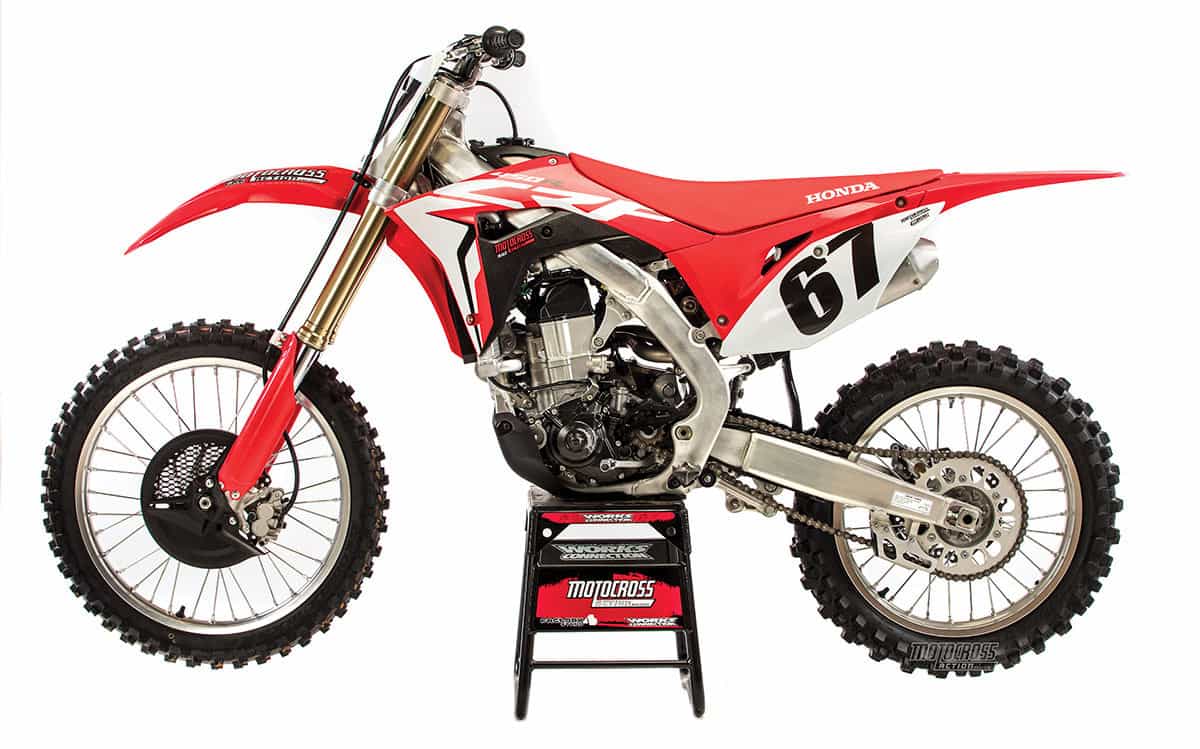 The biggest changes are stiffer shock and fork springs, all-new mapping, thinner head stays and electric starting. Those aren’t just the biggest changes, they are the only changes.
The biggest changes are stiffer shock and fork springs, all-new mapping, thinner head stays and electric starting. Those aren’t just the biggest changes, they are the only changes.
Q: IS THE 2018 CRF450 FASTER THAN THE 2017 CRF450?
A: Yes. Thanks to the new black-box map, the 2018 engine has a better transition of power into the midrange. Last year’s herky-jerky low-to-mid power hasn’t been eliminated, but the erratic burps have been lessened a little. When the CRF450 comes on, it feels very abrupt off the bottom; but, that is a little misleading, because if you try to ride the CRF450 a gear high in slow turns, it will bog—and require clutch work to get it back on the pipe. Many test riders felt it was necessary to downshift into turns to ensure that the engine pulled clean on the exit. We had some gear gaps on the 2018 that we solved in 2017 by going from the stock 49-tooth rear sprocket to a 50. We don’t think this is a good solution with the 2018 powerband.
Where the Honda engine works best is in the middle. It pulls hard after its low-end confusion and, since peak horsepower is very high in the rpm band, you can’t successfully short-shift it or it will go slower. Even though we had some of the same issues in 2018 that we had in 2017, the new engine configuration is more usable and faster than that of the 2017.
Q: DOES THE 2018 CRF450 HANDLE BETTER THAN THE 2017 MODEL?
A: Yes, but not because of any frame-geometry changes, because there aren’t any. What helps the overall chassis feel better are the effects of the stiffer suspension and more flexible head stays. Last year’s chassis was very good at turn-in, but that was the only place that it felt good. After turn-in, it was very loose on exit, as though the front tire had no weight on it. Worse yet, the rear of the 2017 chassis wallowed in the rough. It would drop into its stroke, pogo up and seesaw back and forth. If the bumps weren’t just right, the CRF450 would side-step over in a mini-swap.
On the 2018 CRF450, the firmer suspension makes the whole bike feel more planted to the ground. Turn-in is still very good, but the looseness is still there (once pressure is released coming out of a turn). The stiff shock spring eliminates most of last year’s wallow. The whole bike feels calmer in transitions and in the rough, but there is still considerable headshake on fast, bumpy straights.
Handling is a function of the frame geometry, weight bias, center of gravity and chassis setup. Suspension setup can mask odd handling traits but can rarely erase them. The 2018 Honda CRF450’s handling is better, thanks to its stiffer suspension, but perfect it is not.
 The powerband differences exhibited by the 2018 engine are all the direct results of a new map. In this photo you can see the redesigned headstays. Not only are they more sculpted, but the aluminum casting is thinner.
The powerband differences exhibited by the 2018 engine are all the direct results of a new map. In this photo you can see the redesigned headstays. Not only are they more sculpted, but the aluminum casting is thinner.
Q: HOW GOOD IS THE SUSPENSION?
A: In a lot of ways the MXA wrecking crew has more experience with the 2018 suspension than almost anyone. Early in our test of the 2017 CRF450 we switched to the spring rates of the 2018 CRF450. We feel that the pluses were twofold.
(1) Forks. You might be inclined to believe that the 2018’s stiffer fork springs would make the forks feel too stiff. Not so. Why not? Since the 0.50 fork springs hold the front end higher, there is more available travel to absorb big hits. Additionally, with the stiffer fork springs, the compression damping can be softened up to be more absorptive than last year’s combo of firmer damping and softer springs. However, we did have issues with harshness at the top of the fork’s stroke, followed by a mysterious lack of mid-speed compression damping. The result was a fork that chattered in the braking bumps and dove excessively in big holes and hard landings. These forks need work.
(2) Shock. The 2017 CRF450 had a stinkbug stance—high in the rear and low in the front. This imbalance combined with the overly soft shock spring produced a very busy rear end that was the exact opposite of a dead setup. It moved around a lot, constantly rising and falling in an unsyncopated rhythm. All this movement transferred a lot of load onto the front forks, which worsened their performance. For 2018, the stiffer shock spring was mated to more supple and fluid damping. The added spring rate works with a wider range of rider sizes and compression settings. The overall effect is a major improvement in the feel of the rear of the CRF450.
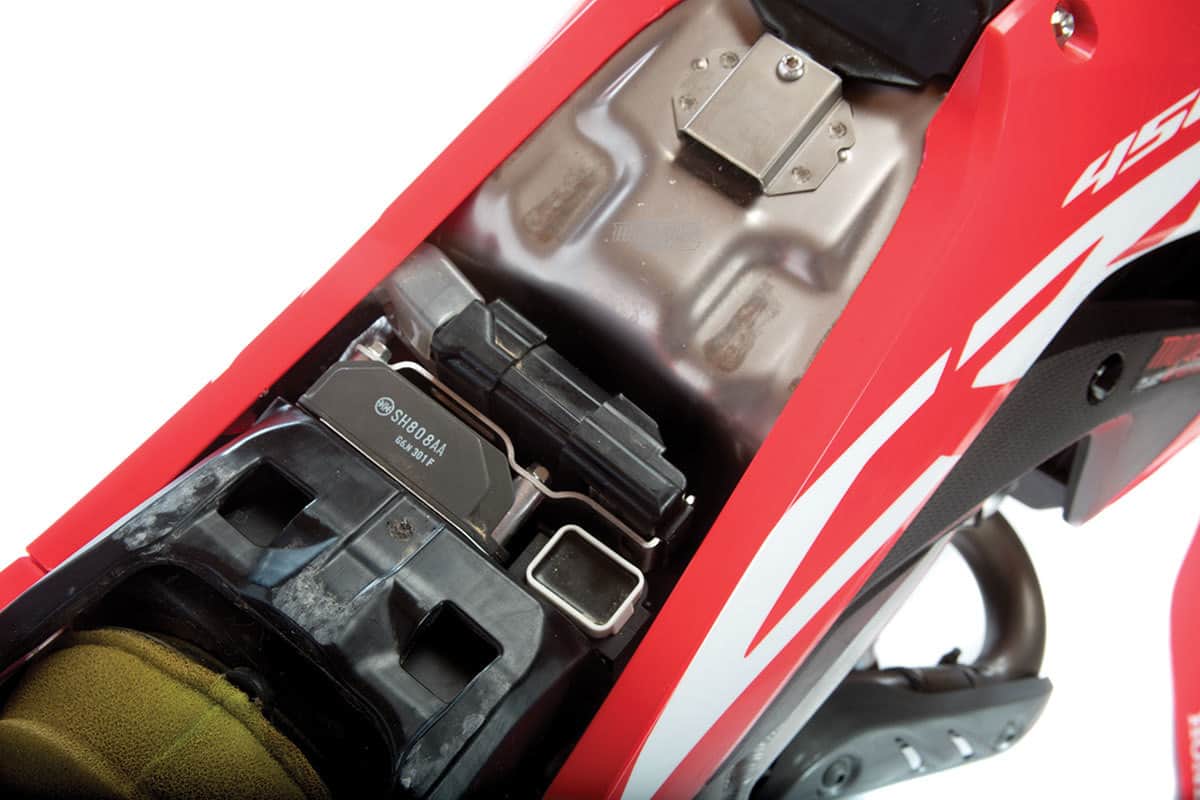 It’s tight under the seat as the airbox shares space with the battery and electronics. The Ti tank squeezes it all in.
It’s tight under the seat as the airbox shares space with the battery and electronics. The Ti tank squeezes it all in.
Q: WHAT ABOUT THE ELECTRIC STARTER?
A: Honda had no reason to reinvent the wheel with its electric starter, thus it is a clone of the KTM system. Power comes from an Eliiy HY85S LiFePO4 (lithium-iron phosphate) battery. Motorcycle manufacturers like to call them “lithium-ion” batteries in their promotional copy, but don’t confuse lithium-iron phosphate batteries with the kind of batteries used in computers, cellphones or cameras. In truth, LiFePO4 batteries are better suited to motocross use because they resist thermal runaway, have a longer calendar life, recharge quicker and offer a higher peak-power rating.
It should be noted that you can’t start your 2018 CRF450 without pulling the clutch lever in; however, Honda downsized the micro-switch from the bulky one that came with last year’s optional electric-start kit. Additionally, you can’t run an aftermarket clutch perch unless you hot-wire the micro-switch. Honda says that you can’t jump-start its battery from a car battery.
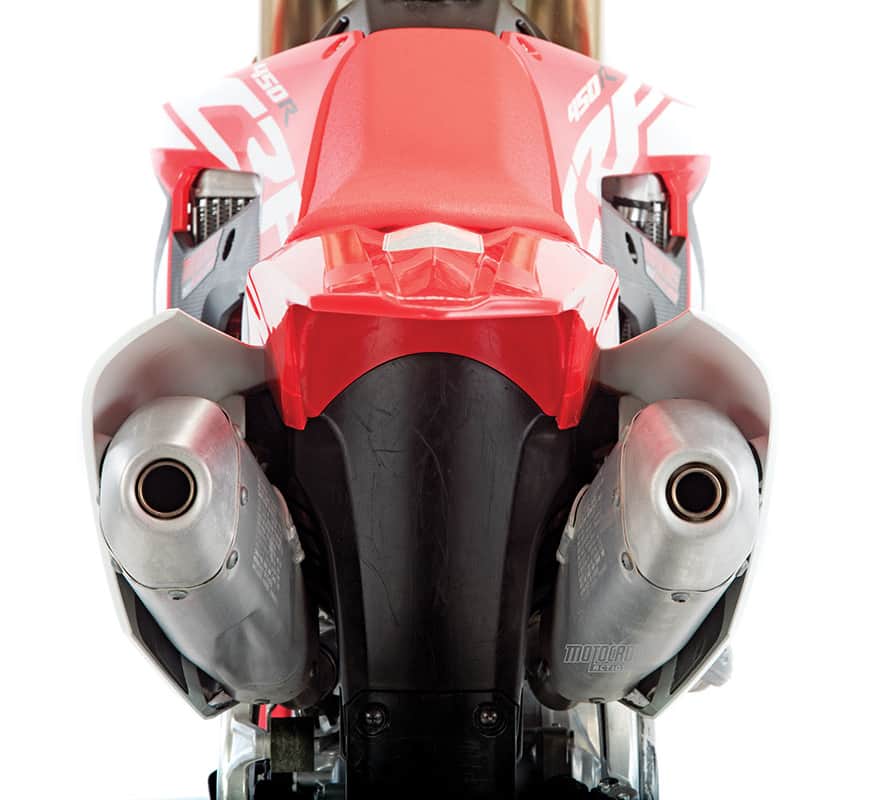 One muffler has a larger opening than the other. Why? To force the exhaust flow to go the long way around.
One muffler has a larger opening than the other. Why? To force the exhaust flow to go the long way around.
Q: WHAT WOULD THE MXA WRECKING CREW CHANGE ON OUR TEST BIKE?
A: You may not like this list, but this is how to get the most from your 2018 CRF450.
(1) Radiator cap. In hot conditions, we pumped water on several occasions. How did we fix it? We drop-kicked the stock 1.1 kg/cm2 radiator cap for a 1.6 kg/cm2 or higher cap. Raising your cooling system’s maximum operating pressure raises your cooling system’s boiling point. As a final step, we switched to Evans Waterless Coolant.
(2) Brakes. We are a long way from the glory days of Honda brakes. The 2018 brakes are pitiful. They don’t want to stop the bike, and then they grind to a halt with a jerk. We drain the stock brake fluid and replace it with Maxima 600 Series brake fluid. This ensures fade-free operation. Next, we remove the front and rear disc guards. In our opinion, Honda’s disc guards hinder airflow to the rotor, calipers and pads, which makes the battle against brake fade more difficult.
(3) Raise the seat. The electric starter’s battery and battery tray eat up valuable air space in the airbox. We compensate for this by super-gluing a 3/8-inch rubber bumper to the bottom of the seat base (back at the rear of the bike). The bumper raises the rear of the seat up off the rear fender, even when you are sitting on it, to allow extra air to flow into the airbox between the seat and rear fender.
(4) Chain guide. The stock rear chain guide has a two-piece rubber glide block inside the aluminum carrier. Mechanically, it makes noises and scratches the sides of the sprocket as it flaps around. You can run the one-piece 2016 chain guide or switch to a TM Designworks Factory Edition SX chain guide.
(5) Frame flex. To make the aluminum chassis more resilient longitudinally and torsionally, we remove the two rear fuel-tank bolts and the two exhaust-pipe bolts where the pipe mounts to the subframe. This softens up the chassis and makes it feel more organic and forgiving. You can try it on a track in a few minutes. If you can’t feel any difference, put the bolts back in. No harm, no foul.
(6) Shock link. Every test rider preferred to run a 1.5mm-longer shock linkage. It paid big dividends in ergos, balance and chassis setup. It lowered the seat height, which allowed us to slide the forks up in the clamps to fine-tune the handling.
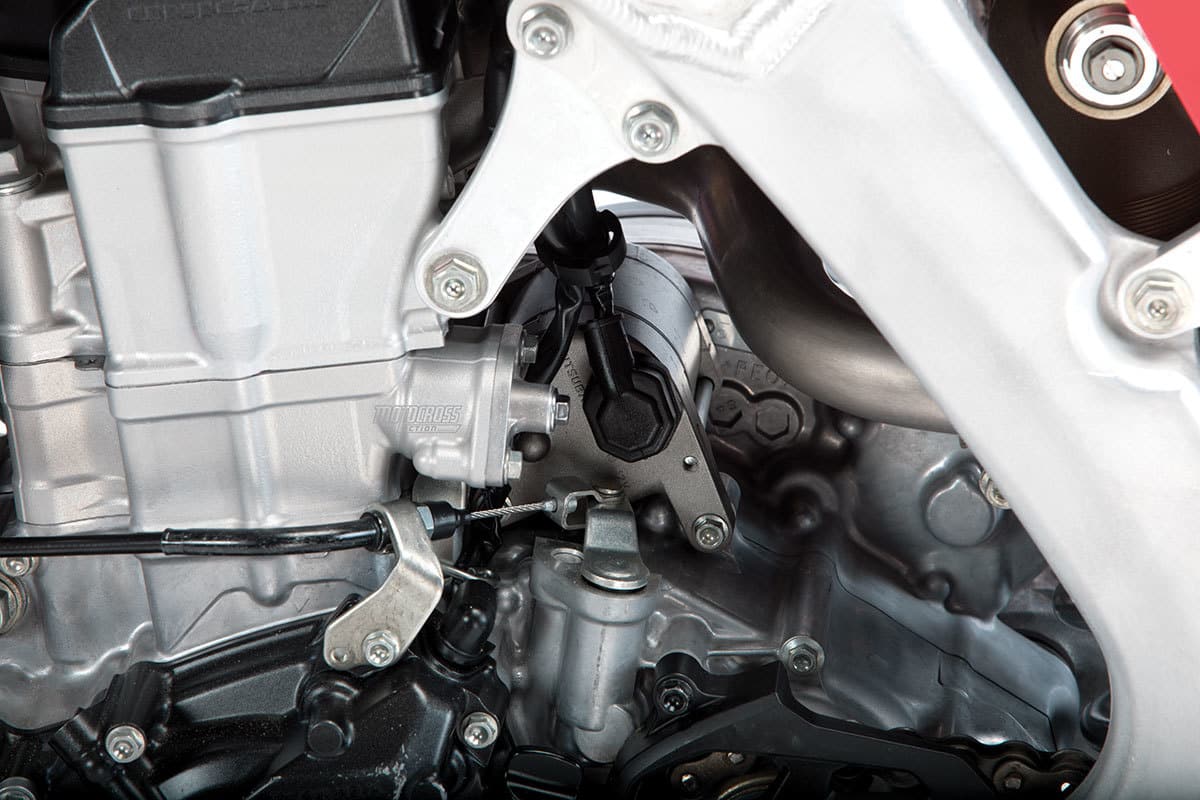 The 2018 electric starter is why the 2018 Honda’s MSRP is $300 more than last year.
The 2018 electric starter is why the 2018 Honda’s MSRP is $300 more than last year.
Q: WHAT DID WE HATE?
A: The hate list:
(1) Radiator louvers. The gaps between the louvers that protect the radiator fins are so widely spaced that within 20 hours of run-time our radiators looked like someone had been hitting them with a tap hammer. Most of the fins were dented. Our quick fix was to mount Twin Air radiator sleeves (after we replaced the destroyed original radiators). Twin Air’s mesh-like screens knock down the hard stuff without hindering airflow. Racing takes a bigger toll on the radiator vanes than play riding, because racers follow in the roost of other racers.
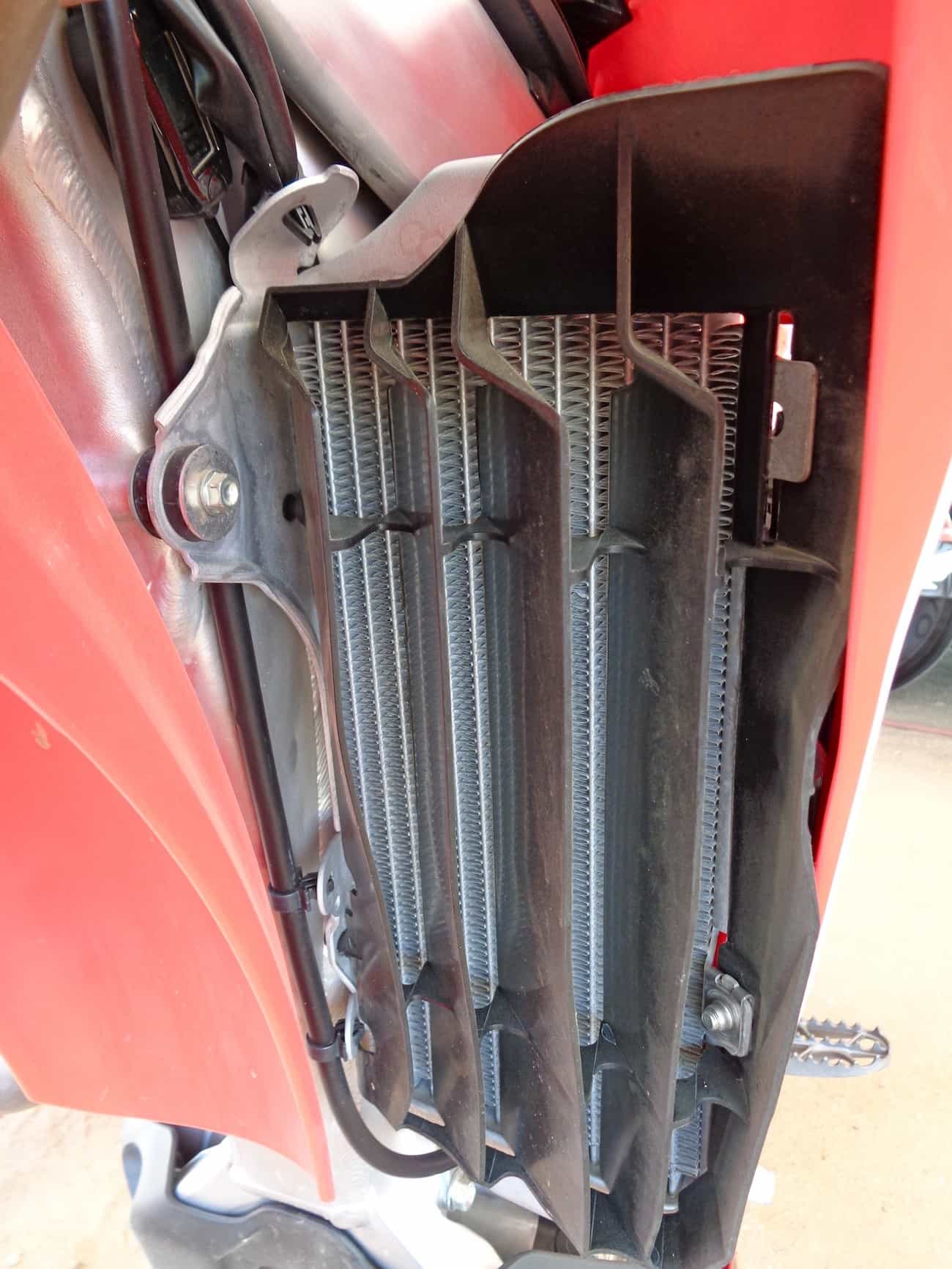 We run Twin Air radiator sleeves over our CRF450 radiators louvers to keep the vanes from being roosted shut.
We run Twin Air radiator sleeves over our CRF450 radiators louvers to keep the vanes from being roosted shut.
(2) Clutch. We aren’t sure why Honda keeps experimenting with different numbers of clutch plates. The new seven-plate clutch uses 2mm-thick drive plates and very stiff clutch springs (using fewer plates requires using stiffer springs). This clutch is much better than the previous CRF units but not at the top of the class. MXA test riders don’t like clutches with judder springs. Not only do they cut down on clutch grip, but the judder plates break. We eventually added stiffer slutch spring to keep the weak CRF450 clutch alive. It should be noted that stiffer clutch spring improve the bite of the clutch but narrows the operating zone—which makes it more diffiuclt to slip with any accuracy.
(3) Brakes. The rotor may be big, but the front isn’t very well modulated. It feels weak when you pull it gently and grabby when you tug on it.
(4) Launch control. The Honda does not have a launch control button.
Q: WHAT DID WE LIKE?
A: The like list:
(1) Midrange power. The CRF450 puts the power to the ground in the midrange like no other bike. It gobbles up ground. On the pipe, in the midrange, with the throttle pegged, this is a great engine. Conversely, we’d like a torquier low-to-mid transition and smoother low-end throttle response off the bottom.
(2) Chassis. It feels sleek—for a 240-pound bike. Honda traded electric starting for added weight…a lot of weight. It is now the second heaviest 450 made.
(3) Valve train. Love the finger-followers. The old Unicam engine and small intake valves had reached their limit.
(4) Engine oil. Unlike the 2016 model, the 2017–2018 CRF450 doesn’t require separate oil chambers. It mixes engine and transmission oil just like every other 450 four-stroke.
(5) Updates. It would have been a shame if the Honda engineers had not been given the budget, albeit small, to make the necessary upgrades to the suspension, mapping and frame-flex issues.
(6) Mapping. Experiment with the three maps. Although most test riders stuck with the stock map (one blue flash), there are situations and riders that might benefit from the mellow (two flashes) or aggressive (three flashes) maps.
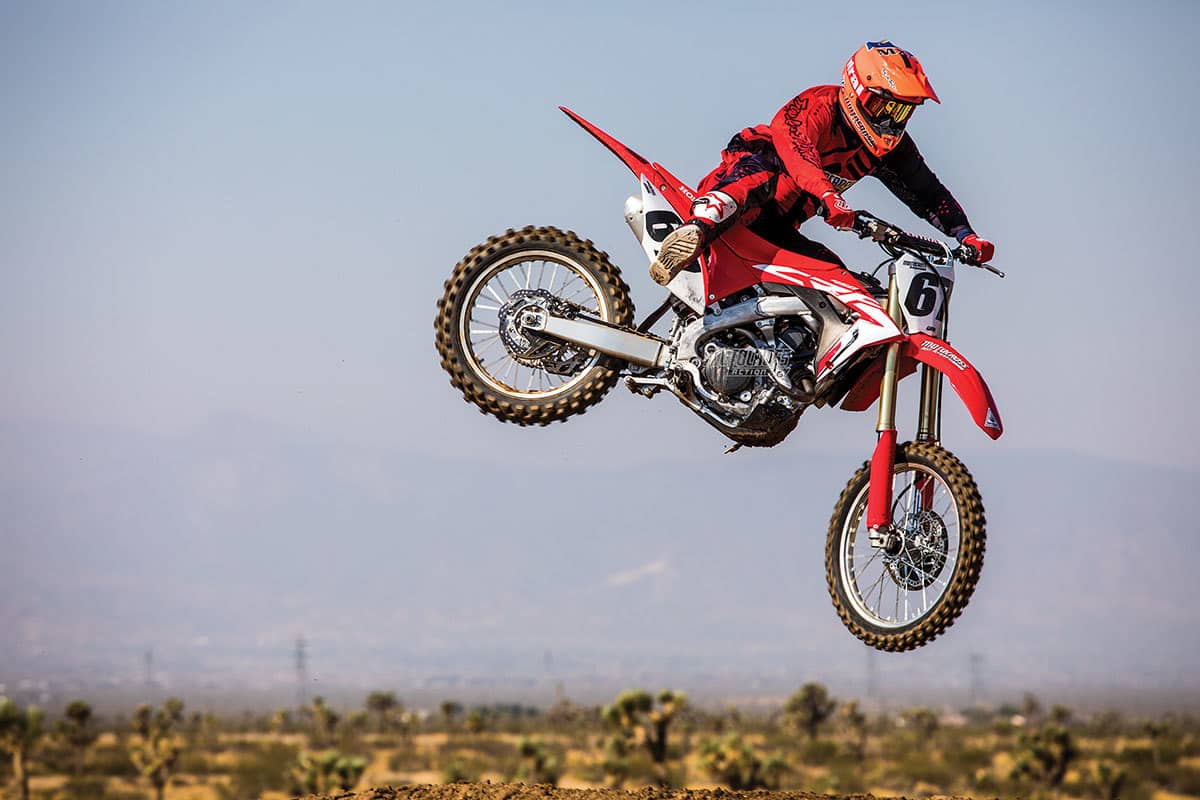 The bad news? The 2018 CRF450 gained seven pounds over the 2017 model. It now weighs 240 pounds. Don’t believe anyone who says that you can’t feel it.
The bad news? The 2018 CRF450 gained seven pounds over the 2017 model. It now weighs 240 pounds. Don’t believe anyone who says that you can’t feel it.
Q: WHAT DO WE REALLY THINK?
A: This is a better Honda, which everyone who bought a 2017 model must have suspected would happen; however, it does not obsolete the 2017 CRF450, because the 2018 head stays retrofit on the 2017. The map changes are available from your local dealer, and better suspension setups can be had from any suspension shop. As for the electric starter, chalk this up to Honda engineers trying to do something to look contemporary in the face of KTM’s dominance. You can live without it, and, for sure, you can live without the 5 extra pounds that come with it. All that said, every MXA test rider felt that the 2018 Honda CRF450 was a better race bike than the 2017 model.
MXA’S 2018 HONDA CRF450 SETUP SPECS
This is how we set up our 2018 Honda CRF450 for racing. We offer it as a guide to help you find your own sweet spot.
SHOWA COIL-SPRING FORK SETTINGS
We are thrilled that Honda put stiffer fork springs in the Showa coil-spring forks, but whatever they did to the compression damping was a step in the wrong direction. They managed to build forks with new damping and stiffer fork springs that have the same flaws as the forks they replaced. Our Pro test riders ran the compression on 10 clicks out and the rebound on 13 clicks out. Intermediate test riders ran both the compression and rebound on 12 clicks out. Vet and Novice test riders went with 13 clicks out on both clickers. The only do-it-yourself fix for the harsh feel in braking bumps and tendency to bottom in big bumps is to add oil to the forks (start at 10cc) and then turn the compression clicker out. For hardcore racing, these are MXA’s recommended 2018 CRF450 fork settings (stock settings are in parentheses):
Spring rate: 0.50 N/m
Compression: 12 clicks out
Rebound: 12 clicks out
Fork-leg height: Second line (first line)
Notes: Don’t be afraid to crank on the compression clickers if you are looking for a suppler feel. We had issues with a very harsh feel in small braking bumps and overly soft feel in bigger bumps and jump landings. We could not iron it out with the clicks available to us until we raised the oil height to stiffen the final four inches of travel. You have to experiment with the clickers for your weight, speed and track conditions.
SHOWA SHOCK SETTINGS
We put the race sag at 107mm to lower the overall bike height while using fork-leg height to balance out the frame geometry. Had we just lowered the rear, it would have kicked the head angle out and slackened the geometry. The 2018 CRF450 is very sensitive to fore/aft balance changes. Any change to the shock seriously affects the forks. When Honda’s engineers stiffened the rear spring rate for 2018, they made the rear end feel more stable in the rough. We start with the low-speed compression at 10 clicks out and the rebound at 7 clicks out. From there, we go out to make the shock softer for Vet riders. High-speed compression varied from 3-1/2 turns out to 3-3/4 turns out. For hardcore racing, these are MXA’s recommended 2018 CRF450 shock settings (stock settings are in parentheses):
Spring rate: 56 N/m
Race sag: 107mm
Hi-compression: 3-1/2 turns out
Lo-compression: 10 clicks out
Rebound: 7 clicks out
Notes: Most MXA test riders preferred to run longer shock links to lower the rear end and stiffen the compression damping at the initial start-up point. If you are light, switch back to last year’s 5.4 N/m spring, but try softening all the clickers on the 2018 shock by four clicks first. The clickers have a fairly significant impact on suspension feel.
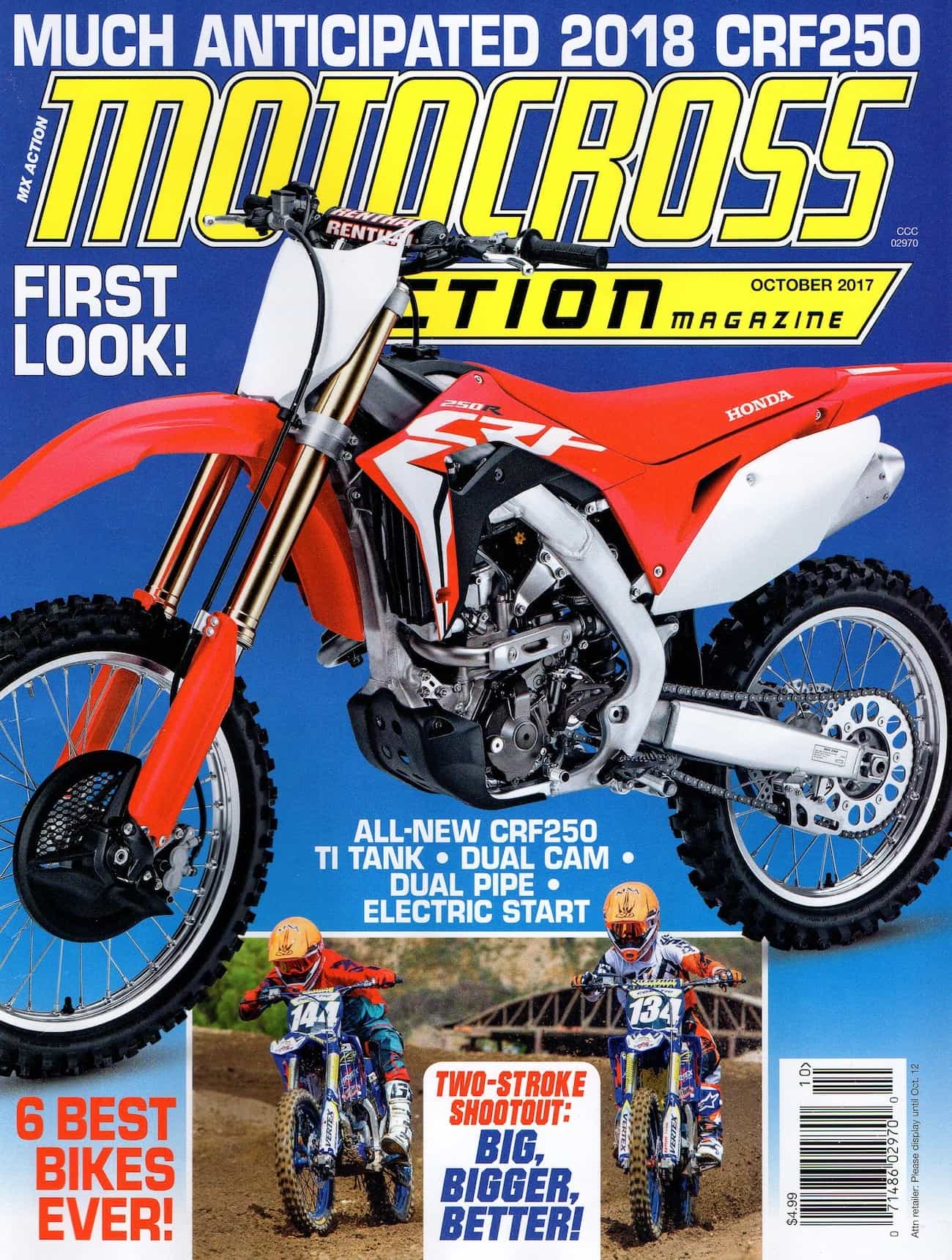 Had you subscribed to MXA, you would have read this complete bike test when in came out back in September. Click the box below to subscribe.
Had you subscribed to MXA, you would have read this complete bike test when in came out back in September. Click the box below to subscribe.


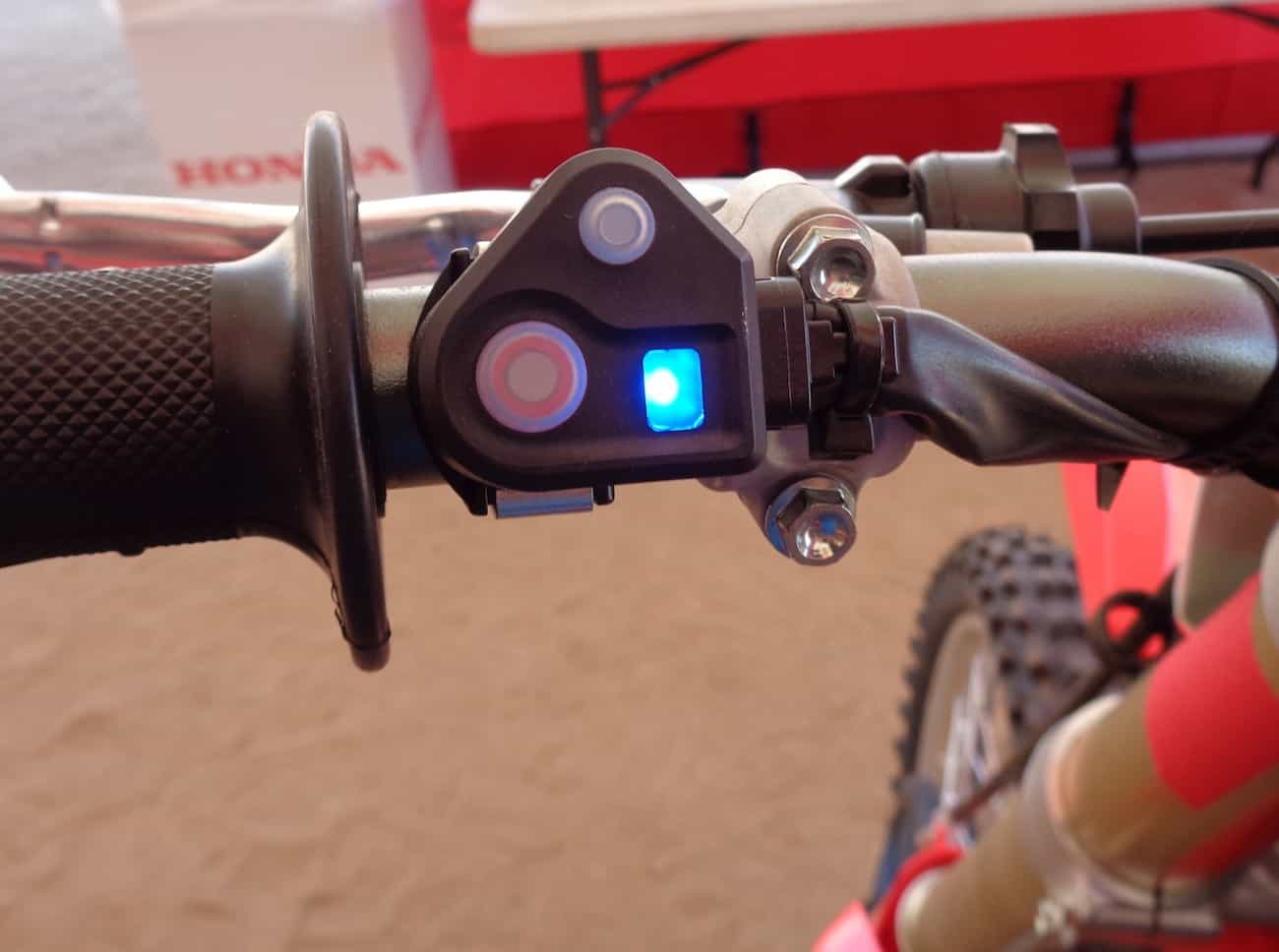

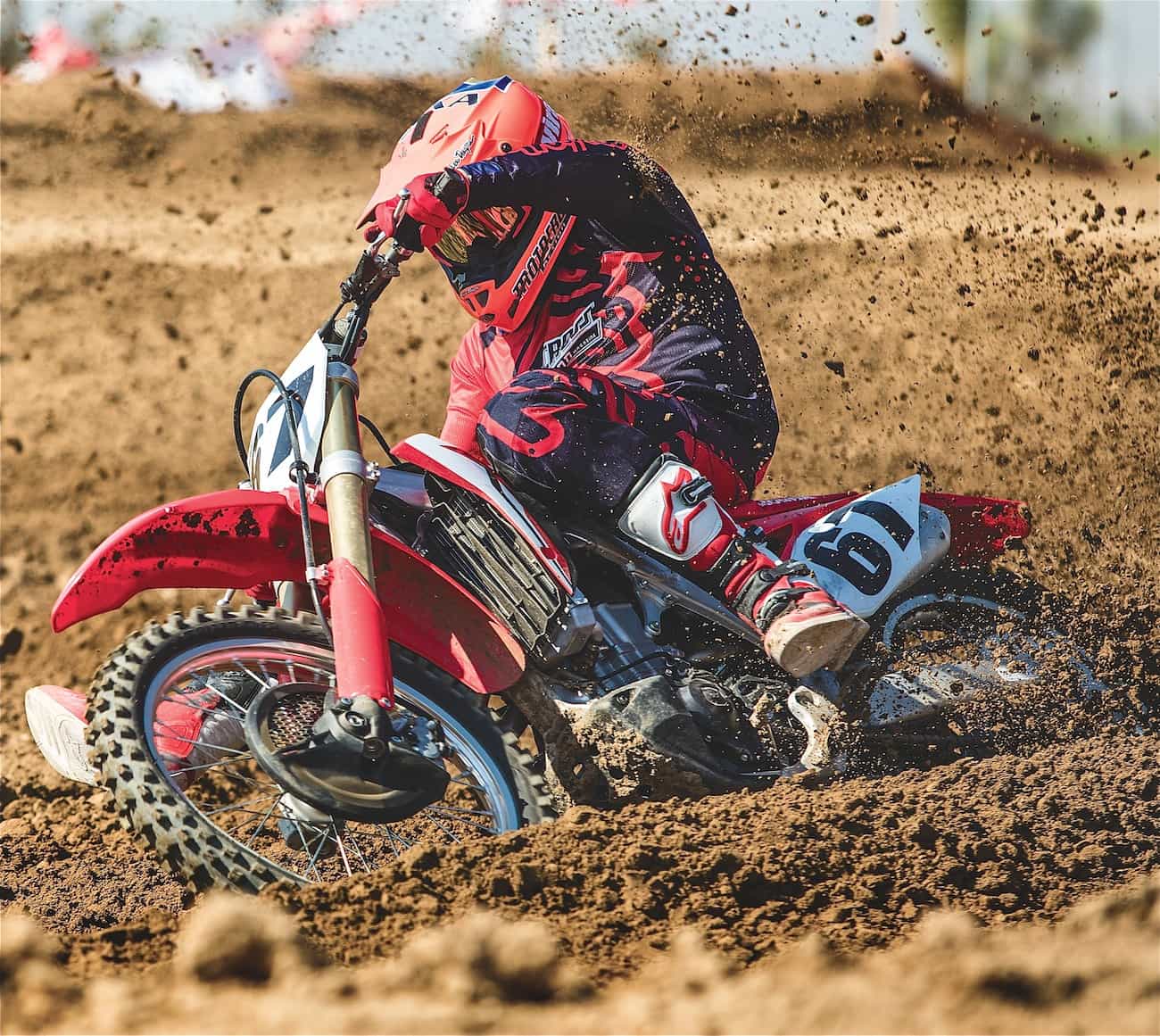





Comments are closed.